
Introduction
The ViewSonic VP3881 is a large ultra-wide
format display, measuring in at 37.5" in size and offering a 24:10 aspect ratio.
It has a 3840 x 1600 resolution which makes it a little larger, and with a
little more desktop room than the common range of 34 - 35" ultrawide monitors on
the market. This model is aimed primarily at professional uses and carries a
range of high end features to enhance colour accuracy and image quality. The
screen uses an IPS technology panel for all round performance, and has a factory
calibration, support for hardware calibration, a massive range of modes and
options and a uniformity correction mode. There are also a wide range of
modern connectivity options offered with DisplayPort, HDMI 2.0 and USB Type-C
offered. We've only tested one other screen of this size in the past, one of the
first of its kind to appear which was the
LG 38UC99, so it will be interesting to see how this ViewSonic offering
compares.
A great deal of time and effort goes in
to the content at TFTCentral, and we are very grateful for the support our
readers show through donations and thank yous. If you would like to support the
site and help us continue to produce high quality, detailed content, we would
welcome a
donation
no matter how small or large. Thank you.

|
Check Pricing and Buy - Direct Links
|
|
Amazon
|
|
TFTCentral is a participant
in the Amazon Services LLC Associates Programme, an affiliate
advertising programme designed to provide a means for sites to earn
advertising fees by advertising and linking to Amazon.com, Amazon.co.uk,
Amazon.de, Amazon.ca and other Amazon stores worldwide. We also
participate in a similar scheme for Overclockers.co.uk. |

Specifications and
Features
The following table gives detailed
information about the specs of the screen as advertised:
|
Monitor
Specifications |
|
Size |
37.5" |
Panel Coating |
Light AG coating |
|
Aspect
Ratio |
24:10 curved 2300R |
Interfaces |
1x
DisplayPort, 2x HDMI 2.0, 1x USB Type-C, 3x USB 3.0, 1x audio in, 1x audio
out
|
|
Resolution |
3840 x 1600 |
|
Pixel Pitch |
0.229mm |
Design
colour |
Matte black bezels with
charcoal grey stand |
|
Response Time |
7ms G2G (with OD), 14ms G2G
typ |
Ergonomics |
Tilt, 130mm height, swivel, rotate |
|
Static Contrast Ratio |
1000:1 |
|
Dynamic Contrast Ratio |
20 million:1 |
VESA Compatible |
Yes 100mm |
|
Brightness |
300 cd/m2 |
Accessories |
DisplayPort, HDMI, USB
type-C, USB and audio
cables. Power cable and brick |
|
Viewing Angles |
178 / 178 |
|
Panel Technology |
LG.Display IPS |
Weight |
with stand: 12.7 Kg |
|
Backlight Technology |
W-LED |
Physical Dimensions |
(WxHxD) with stand
896 x 630 x 300 mm |
|
Colour Depth |
1.07b (8-bit+FRC) |
|
Refresh Rate |
60Hz |
Special
Features |
Audio in/out, 3x USB
3.0 ports, 2x 5W speakers, hardware calibration, uniformity correction mode,
PiP and PbP support |
|
Colour
Gamut |
Standard gamut, sRGB
~72% NTSC |
The VP3881 offers a good range of connectivity for
a modern screen with 1x DisplayPort, 1x USB type-C and 2x HDMI 2.0 offered for
video connections, and an additional 3 port USB 3.0 hub, with the ports located
on the back of the screen. The screen has an external power supply and comes
packaged with the power cable and brick you need. An audio input and output
connection is provided along with integrated 2x 5W stereo speakers.
Below is a summary of the features and
connections of the screen:
|
Feature |
Yes / No |
Feature |
Yes / No |
|
Tilt adjust |
 |
DVI |
 |
|
Height adjust |
 |
HDMI |
 |
|
Swivel adjust |
 |
D-sub |
 |
|
Rotate adjust |
 |
DisplayPort |
 |
|
VESA compliant |
 |
Component |
 |
|
USB 2.0 Ports |
 |
Audio connection |
 |
|
USB 3.0 Ports |
 |
HDCP Support |
 |
|
Card Reader |
 |
MHL Support |
 |
|
Ambient Light Sensor |
 |
Integrated Speakers |
 |
|
Human Motion Sensor |
 |
PiP / PbP |
 |
|
Touch Screen |
 |
Blur Reduction Mode |
 |
|
Factory calibration |
 |
G-Sync |
 |
|
Hardware calibration |
 |
FreeSync |
 |
|
Uniformity correction |
 |
Wireless charging |
 |

Design and
Ergonomics


Above: front views of the screen. Click for larger versions
The VP3881 comes in a mostly all black
design, with matte black plastics used for the front bezels and the front of the
monitor arm. There is a 3 side "borderless" design to this model with a very
thin 2mm black plastic edge around the sides and top. There is then an 8.5mm
black panel border before the image starts, giving a total dark edge around the
sides and top of ~10.5mm. Along the bottom edge is a thicker traditional bezel
measuring 20mm in thickness.
There is a a very large base to the stand
which is finished in a dark charcoal grey colour with a semi-glossy finish to
it. This provides a very sturdy and wide base for the large screen, but it is
pretty chunky and deep. It is about 290mm deep in total, so make sure your desk
can accommodate it ok and you can have the screen far enough back for a
comfortable viewing position. There is a small section of glossy black plastic
where the arm connects in to the base and provides the side to side swivel
adjustment mechanism.


Above: rear views of the screen. Click for larger version
The back of the screen is encased in a matte
black plastic. The stand attaches in the middle and has a quick release
mechanism, being removable if you want to VESA 100 mount the
screen another way. The back of the stand is finished in the same dark
charcoal grey plastic as the base, and it's darker than it looks in the above
product images. There's a carry handle at the top of the arm which is handy as
it's a big and heavy display.



Above: side view of the screen. Click for larger version
From the side the screen itself has a
reasonably thin profile although it looks thick in this image because of the
curved format. With the stand attached it has a fairly deep
footprint as we said earlier.
There is a good range of ergonomic
adjustments offered by the stand. Tilt offers a wide range and is smooth to
move, if a little stiff to operate. There is a 130mm height adjustment which is
again a little stiff to move but is smooth. At the lowest setting the bottom edge of the screen is
100mm from
the top of the desk, and 230mm when at maximum height extension. Side to side
swivel is provided and is smooth and easy to use. There's no rotation on this
model due to the large size and curved format. The stand provides a very strong and
sturdy base for the large screen although there's still a bit of wobble as you
move it around.
A summary of the ergonomic adjustments are
shown below:
|
Function |
Range |
Smoothness |
Ease of
Use |
|
Tilt |
Yes |
Smooth |
A little stiff |
|
Height |
130mm |
Smooth |
A little stiff |
|
Swivel |
Yes |
Smooth |
Easy |
|
Rotate |
n/a |
- |
- |
|
Overall |
Good set of adjustments
and generally all easy enough to move. A little wobble due to the large
screen size |
The materials were of a good
standard and the build quality felt decent. There was no audible noise from the
screen, even when conducting specific tests which can often identify buzzing
issues. The whole screen remained cool even during prolonged use as well which
was pleasing.

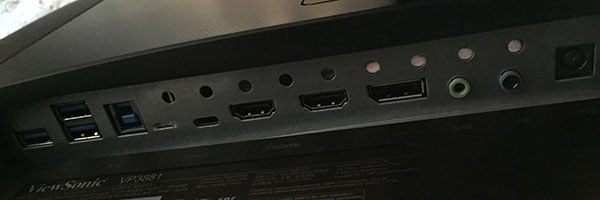
Above: connection options on the back of the screen
The back of the screen features the
connections. There are the USB type-C, 2x HDMI 2.0 and DisplayPort 1.2
connections for video, along with 3x USB 3.0
downstream, 1x USB upstream and an audio input and output. The power
connection is on the far right hand end. It would have
been nice to see some USB ports on the side of the screen for easier access
perhaps as the provided ports are a bit tucked away.
The
OSD is controlled through a 5 pressable buttons located on the back of the
screen, in the lower right hand corner. There is also a power on/off button
here. Navigation was sometimes a bit tricky, as it wasn't always obvious which
button you were using at the back, and the labels in the OSD to try and tell
you what action you're taking are sometimes a bit hard to line up with where
your fingers are at the back. We found ourselves making the wrong selections a
fair amount and sometimes even turning the screen off accidentally with the
bottom power button which was annoying. There was a really wide range of
settings and options though in the OSD menu, and you did get used to the
navigation after a little bit of use. Not the most intuitive menu but not
horrible.

Power Consumption
In terms of power consumption the
manufacturer lists a typical usage of 155W, maximum of 170W and 0.3W in standby.
We carried out our normal tests to establish its power consumption ourselves.
|
 |
|
State and Brightness Setting |
Manufacturer Spec (W) |
Measured Power Usage (W) |
|
Default (100%) |
155.0 |
63.4 |
|
Calibrated (24%) |
- |
36.1 |
|
Maximum Brightness
(100%) |
170.0 |
63.4 |
|
Minimum Brightness
(0%) |
- |
29.8 |
|
Standby |
0.3 |
0.5 |
|
Out of the box the screen used 63.4W at the
default 100% brightness setting. The additional power draw in the spec will be
related to having things connected via USB, especially the Type-C interface. Once calibrated the screen reached
36.1W
consumption, and in standby it used only 0.5W. We have plotted these results
below compared with other screens we have tested. The consumption (comparing the
calibrated states) is pretty similar to most screens in this size range as you
might expect including the similar LG 38UC99.


Panel and Backlighting
|
Panel Manufacturer |
LG.Display |
Colour Palette |
1.07 billion |
|
Panel Technology |
IPS |
Colour Depth |
8-bit + FRC |
|
Panel Module |
LM375QW1-SSA1 |
Colour space |
Standard gamut |
|
Backlighting Type |
W-LED |
Colour space coverage (%) |
sRGB, 72% NTSC coverage |
Panel Part and Colour Depth
The ViewSonic VP3881 features an
LG.Display LM375QW1-SSA1 IPS technology panel which is capable of producing
1.07 billion colours. This is achieved through a 8-bit+FRC colour depth as
detailed in the specification. Keep in mind whether this 10-bit support is
practically useable and whether you're ever going to truly use that
colour depth. You need to have a full 10-bit end to end workflow to take
advantage of it which is still quite expensive to achieve and rare in the
market, certainly for your average user. This includes relevant applications and
graphics cards as well, so to many people this 10-bit support might be
irrelevant. This is the first panel of this size and format we have seen. The
panel part is confirmed when dismantling the screen as shown below:

Screen
Coating
The
screen coating is a light anti-glare (AG) offering. It isn't a semi-glossy
coating, but it is light as seen on other modern IPS type panels. Thankfully it
isn't a heavily grainy coating like some old IPS panels feature and is also
lighter than modern TN Film panel coating. It retains its anti-glare properties
to avoid too many unwanted reflections of a full glossy coating, but does not
produce too grainy or dirty an image that some thicker AG coatings can.
Backlight Type and Colour Gamut
The screen uses a White-LED (W-LED) backlight
unit which is standard in today's market. This helps reduce power consumption
compared with older CCFL backlight units and brings about some environmental
benefits as well. The W-LED unit offers a standard colour gamut which is
approximately equal to the sRGB colour space. Anyone wanting to work with wider
colour spaces would need to consider some of the wide gamut displays available
instead. If you want to read more about colour spaces and gamut then please have
a read of our
detailed article.
Backlight
Dimming and Flicker
We tested the screen to establish the methods
used to control backlight dimming. Our in depth article talks in more details
about a previously very common method used for this which is called
Pulse Width Modulation (PWM). This in itself gives cause for concern to some
users who have experienced eye strain, headaches and other symptoms as a result
of the flickering backlight caused by this technology. We use a photosensor +
oscilloscope system to measure backlight dimming control with a high level of
accuracy and ease. These tests allow us to establish
1) Whether PWM is being used to control the
backlight
2) The frequency and other characteristics at which this operates, if it is used
3) Whether a flicker may be introduced or potentially noticeable at certain
settings
If PWM is used for backlight dimming, the
higher the frequency, the less likely you are to see artefacts and flicker. The
duty cycle (the time for which the backlight is on) is also important and the
shorter the duty cycle, the more potential there is that you may see flicker.
The other factor which can influence flicker is the amplitude of the PWM,
measuring the difference in brightness output between the 'on' and 'off' states.
Please remember that not every user would notice a flicker from a backlight
using PWM, but it is something to be wary of. It is also a hard thing to
quantify as it is very subjective when talking about whether a user may or may
not experience the side effects.
100%
50%
0%



Above scale
= 1 horizontal grid = 5ms
At all brightness settings a constant
Direct Current (DC) voltage is applied to the backlight, and the screen is
free from the obvious off/on switching of any PWM dimming method. As a result,
the screen is flicker free as advertised.
|
Pulse
Width Modulation Used |
No |
|
Cycling
Frequency |
n/a |
|
Possible Flicker at |
|
|
100% Brightness |
No |
|
50% Brightness |
No |
|
0% Brightness |
No |

Brightness
and Contrast
We wanted to measure the luminance range
available from the backlight as well as see how much variance there
was in the screens contrast as we adjusted the monitor setting for brightness.
In theory, brightness and contrast are two independent parameters, and good
contrast is a requirement regardless of the brightness adjustment.
Unfortunately, such is not always the case in practice. We recorded the
screens luminance and black depth at various OSD brightness settings, and
calculated the contrast ratio from there. Graphics card settings were left at
default with no ICC profile or calibration active. Tests were made using an
X-rite i1 Display Pro colorimeter. It should be noted that we used the
BasICColor calibration software here to record these, and so luminance at
default settings may vary a little from the LaCie Blue Eye Pro report.
|
OSD
Brightness |
Luminance
(cd/m2) |
Black Point (cd/m2) |
Contrast Ratio
( x:1) |
|
100 |
327.85 |
0.33 |
993 |
|
90 |
300.89 |
0.30 |
1003 |
|
80 |
274.84 |
0.27 |
1018 |
|
70 |
248.43 |
0.25 |
994 |
|
60 |
220.36 |
0.22 |
1002 |
|
50 |
193.02 |
0.19 |
1016 |
|
40 |
165.25 |
0.16 |
1033 |
|
30 |
135.61 |
0.13 |
1043 |
|
20 |
106.69 |
0.10 |
1067 |
|
10 |
77.27 |
0.08 |
966 |
|
0 |
47.32 |
0.05 |
946 |
|
Total Luminance Adjustment Range
(cd/m2) |
280.53 |
Brightness OSD setting
controls backlight? |
 |
|
Total Black Point Adjustment Range (cd/m2) |
0.28 |
|
Average Static Contrast Ratio |
1007:1 |
PWM Free? |
 |
|
Recommended OSD setting for 120 cd/m2 |
24 |
At the top end the maximum luminance reached
a high 328
cd/m2
which was a little higher even than the specified maximum brightness of 300 cd/m2
from the manufacturer. There was a good 281 cd/m2 adjustment range in
total, so at the minimum setting you could reach down to a fairly low luminance
of 47 cd/m2. This should be low enough for most people including
those wanting to work in darkened room conditions with low ambient light. A
setting of 24 in the OSD
menu should return you a luminance of around 120 cd/m2 at default
settings.
It should be noted
that the brightness regulation is controlled without the need for
Pulse Width Modulation for all brightness settings so the screen is flicker
free.

We have plotted the
luminance trend on the graph above. The screen behaves as it should in this
regard, with a reduction in the luminance output of the screen controlled by the
reduction in the OSD brightness setting. This is a linear relationship
as you can see.

The average contrast ratio of the screen
was measured at 1007:1 which was good for an IPS-type panel. This remains pretty
stable across the brightness adjustment range, with a small drop at the lowest
settings between 20 and 0%.

Testing
Methodology
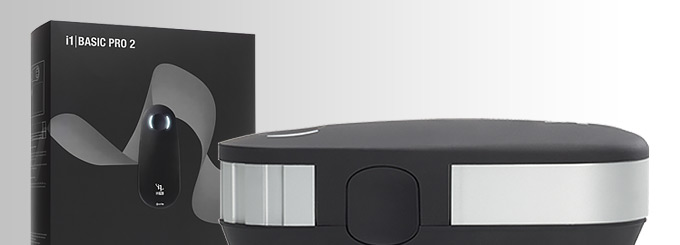
An important thing to consider for most users
is how a screen will perform out of the box and with some basic manual
adjustments. Since most users won't have access to hardware colorimeter tools,
it is important to understand how the screen is going to perform in terms of
colour accuracy for the average user.
We restored our graphics card to default
settings and disabled any previously active ICC profiles and gamma corrections.
The screen was tested at default factory settings using our new
X-rite i1 Pro 2
Spectrophotometer combined with
LaCie's Blue Eye Pro software suite. An X-rite i1 Display Pro colorimeter
was also used to verify the black point and contrast ratio since the i1 Pro 2
spectrophotometer is less reliable at the darker end.
Targets for these tests are as follows:
-
CIE Diagram - validates the colour
space covered by the monitors backlighting in a 2D view, with the black triangle
representing the displays gamut, and other reference colour spaces shown for
comparison
-
Gamma - we aim for 2.2 which is the
default for computer monitors
-
Colour temperature / white point - we
aim for 6500k which is the temperature of daylight
-
Luminance - we aim for 120
cd/m2,
which is the recommended luminance for LCD monitors in normal lighting
conditions
-
Black depth - we
aim for as low as possible to maximise shadow detail and to offer us the best
contrast ratio
-
Contrast ratio -
we aim for as high as possible. Any dynamic contrast ratio controls are turned
off here if present
-
dE average / maximum
- as low as possible.
If DeltaE >3, the color displayed is significantly different from the
theoretical one, meaning that the difference will be perceptible to the viewer.
If DeltaE <2, LaCie considers the calibration a success; there remains a slight
difference, but it is barely undetectable. If DeltaE < 1, the color fidelity is
excellent.

Default Performance
and Setup
The VP3881 carries a factory calibration in some of the preset modes, but this
does not include the out of the box setup. We will test this default setup first
and then look at the factory calibration in a moment.
Default settings of the screen were as follows:
ViewSonic VP3881
Default Settings
 

|

 |
|
Monitor
OSD Default Settings |
|
|
View mode |
Off |
|
Brightness |
100 |
|
Contrast |
70 |
|
Color Adjust |
n/a (Custom mode) |
|
Color Temperature |
Native |
|
Gamma |
2.2 |
|
RGB |
99, 97, 100 |
|
Luminance
Measurements |
|
|
luminance (cd/m2) |
333 |
|
Black Point (cd/m2) |
0.34 |
|
Contrast Ratio |
993:1 |
|
Colour
Space Measurements |
|
|
sRGB coverage |
105.7% |
|
DCI-P3 coverage |
77.9% |
|
Rec.2020 coverage |
55.9% |
|
Initially out of the box the screen was set
with the View mode (various presets for different uses) set to 'off' and the
Color Adjust menu set to 'custom' and not in any of the factory calibrated
'Standard Color' modes. There's quite a few settings and options in the menu on
this screen but basically the View modes offer settings for uses like movies,
games etc, and the 'Standard Color' setting offers the factory calibrated states
for sRGB, EBU, Rec 709 etc. Anyway, out of the box this custom mode had preset
settings as shown above. The display was set with a
very high 100% brightness which was too bright and uncomfortable to use. You
will definitely need to turn that down. The colours felt decent and well
balanced, and you could tell the screen was using a standard sRGB colour space
backlight.
We went ahead and measured the default state
with the i1 Pro 2. The
CIE diagram
on the left of the image confirms that the monitors colour gamut (black
triangle) matches the sRGB colour space reference
(orange triangle) closely. We measured using ChromaPure software a 105.7% sRGB gamut
coverage which corresponds to 77.9% of the DCI-P3 reference and 55.9% of the
Rec.2020 reference. This screen is only designed to be a standard sRGB display,
so this was expected. It was good to see a full 100% sRGB coverage with no
under-coverage, and only a small amount of over-coverage.
Default gamma was recorded at 2.2
average, with a very small 1% deviance from the target which was great news. The
gamma looked to be a little off in the lighter grey shades. White point was measured
at a very accurate 6488k being basically spot on to our 6500k target. Luminance
was recorded at a very bright 333
cd/m2
which is far too high for prolonged general use, you will need to turn that
down. The screen was set at a default 100% brightness in the OSD menu but that
is easy to change of course to reach a more comfortable setting without
impacting any other aspect of the setup. The black depth was 0.34 cd/m2
at this default brightness setting, giving us a good static contrast ratio for
an IPS-type panel of 993:1. We have seen some IPS panels reach up to around 1200
- 1400:1 but somewhere around 1000:1 is still decent for this technology.
Colour accuracy was very good out of the box
with an average dE of 1.4 and a maximum of 5.2. Testing the screen
with colour gradients showed smooth gradients with only minor gradation evident
in the darker tones. There was no sign of any colour banding which was good
news.
Color Temp Setting Measurements
|
Colour
Temp setting |
White
point measurement |
|
Panel Default |
6413k |
|
Bluish |
9352k |
|
Cool |
7536k |
|
Native (Default) |
6488k |
|
Warm |
5051k |
|
User |
6425k |
We carried out a test of the various Color
Temperature modes as well out of interest and the results as shown above. The
native mode was closest to our 6500k target which was good news. The other modes
behaved as they should, offer various options for a cooler or warmer setup.

Factory Calibration
The ViewSonic website explains the factory
calibration offered from the VP3881: "Each of our monitors is factory calibrated to deliver an amazing
Delta E<2 value and includes a detailed calibration report for sRGB, EBU, SMPTE-C,
Rec. 709, and DICOM-SIM color spaces. Whether you’re a photographer shooting in
sRGB, or a video editor in need of REC 709/SMPT-C/EBU standards, rest assure
that this monitor can deliver the accuracy you need to complete your best work."
The screen comes with a factory calibration
report unique to the screen you have, showing the calibration in various modes.
A copy of the report which came with our sample is included below:
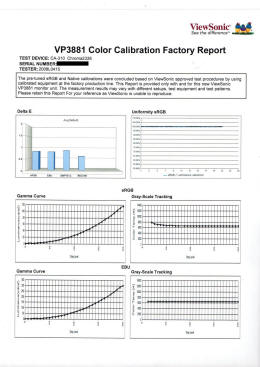
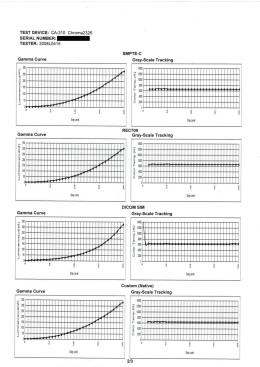
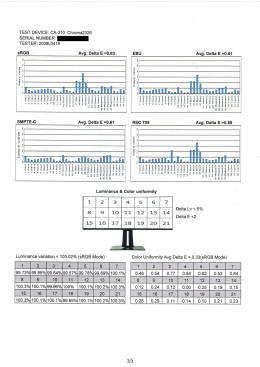
Above:
provided factory calibration report. Click for
larger versions
We measured the screen in the sRGB factory
calibration mode as an example:
ViewSonic VP3881
Factory Calibrated sRGB Mode
Settings
 

|
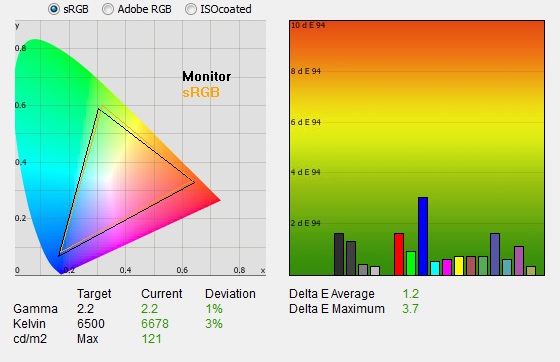
 |
|
Monitor
OSD Default Settings |
|
|
View mode |
Off |
|
Brightness |
n/a |
|
Contrast |
n/a |
|
Color Adjust |
sRGB |
|
Color Temperature |
n/a |
|
Gamma |
n/a |
|
RGB |
n/a |
|
Uniformity |
On / Off |
|
Luminance
Measurements |
|
|
luminance (cd/m2) |
121 or 319 |
|
Black Point (cd/m2) |
0.25 or 0.33 |
|
Contrast Ratio |
485:1 or 972:1 |
|
Colour
Space Measurements |
|
|
sRGB coverage |
98.3% |
|
DCI-P3 coverage |
72.5% |
|
Rec.2020 coverage |
52.0% |
|
When you first set this mode, pretty much all
of the colour adjustment settings are unavailable and greyed out. This includes
the brightness control as well, but actually this is because the
Uniformity
Correction mode gets activated by default when you first enable this sRGB
factory calibrated mode. In some of the other factory calibrated modes the
brightness control can still be accessed even with uniformity correction
enabled. We went ahead and measured the screen as normal.
There is a small change in the colour gamut
of the screen and you can see in the CIE diagram on the left that the black
triangle representing the monitors colour space is a little smaller than the
out-of-the-box mode, and cuts down on some of the small over-coverage we saw
before. We measured now a 98.3% sRGB gamut coverage so it had dipped a little
bit under 100% coverage in this mode in green shades.
Gamma remained very close to the 2.2 target
with a small 1% deviance measured, this time the gamma curve seemed to be a
little off in the darker tones and better in the lighter tones. White point had
drifted a little away from the target, now measured with a 3% deviance at 6678k
and a little too cool.
Colour accuracy was very good though with a dE average of 1.2 measured and a
maximum of 3.7. Colour
gradients remained smooth and banding-free.
The one issue in these settings is the low
contrast ratio of only 485:1, which was a result of having the uniformity
correction enabled. It's perfectly normal for those settings to have a big
impact on contrast ratio, but you can also turn off this feature if you want to
boost contrast ratio back up. With it enabled, the luminance actually ended up
at a comfortable 121
cd/m2, but
you cannot change the brightness control yourself with this feature turned on.
There's a big jump in luminance up to 319
cd/m2 if
you turn uniformity correction off, and the contrast ratio goes back to a much
better 972:1. You'd need to turn the
brightness control down if you turn that uniformity correction off in this mode.

Calibration
We used the
X-rite i1 Pro 2
Spectrophotometer combined with the LaCie Blue Eye Pro software package to
achieve these results and reports. An X-rite i1 Display Pro colorimeter was used
to validate the black depth and contrast ratios due to lower end limitations of
the i1 Pro device.
ViewSonic VP3881
Calibrated
Settings
 

|

 |
|
Monitor
OSD Default Settings |
|
|
View mode |
Off |
|
Brightness |
24 |
|
Contrast |
70 |
|
Color Adjust |
n/a (Custom mode) |
|
Color Temperature |
User |
|
Gamma |
2.2 |
|
RGB |
99, 99, 100 |
|
Luminance
Measurements |
|
|
luminance (cd/m2) |
121 |
|
Black Point (cd/m2) |
0.11 |
|
Contrast Ratio |
1058:1 |
|
Colour
Space Measurements |
|
|
sRGB coverage |
105.9% |
|
DCI-P3 coverage |
78.1% |
|
Rec.2020 coverage |
56.0% |
|
We reverted to the custom mode in the menu
which gives you access to the white point settings and full control over things
like brightness, contrast and the RGB channels for calibration. Settings were
adjusted as shown in the table above, as guided during the calibration process
and measurements.
These OSD changes allowed us to obtain an optimal hardware starting point and
setup before software level changes would be made at the graphics card level. We
left the LaCie software to calibrate to "max" brightness which would just
retain the luminance of whatever brightness we'd set the screen to, and would
not in any way try and alter the luminance at the graphics card level, which can
reduce contrast ratio. These adjustments before profiling the screen would help
preserve tonal values and limit banding issues. After this we let the software
carry out the LUT adjustments and create an
ICC profile.
Average gamma was measured at 2.2 average (0%
deviance) which fixed the very small 1% deviance we'd seen out of the box at default
settings. The accurate white point of the default mode was maintained here, and
we measured a colour temperature of 6504k, spot on with our target basically. Luminance
had been improved thanks to the adjustment to the brightness control and was now
being measured at a far more comfortable 121
cd/m2.
This left us a black depth of 0.11 cd/m2 and a static contrast ratio
of 1058:1 which was good for IPS panel technology. Colour accuracy of the resulting profile was excellent too, with dE
average of 0.5 and maximum of 1.0. LaCie would consider colour fidelity to be
excellent.
Testing the screen with various colour
gradients showed smooth transitions with only some minor gradation in darker
tones.
You can use our settings
and try our calibrated ICC profile if you wish, which are available in
our ICC profile database. Keep in mind that results will vary from one
screen to another and from one computer / graphics card to another.
Hardware calibration
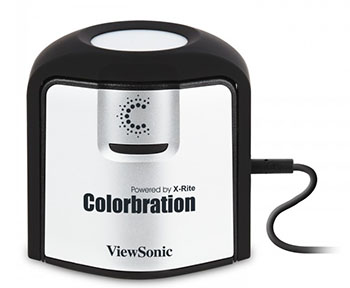

The ViewSonic VP3881 supports hardware level
calibration, allowing you to make adjustments to the 14-bit internal Look Up
Table (LUT) and to store settings and calibrations within the monitor hardware
itself. This is very useful for professional users to ensure consistent
accuracy, without needing to rely on software profiles at an application level.
Because the calibration is saved in the monitor, it is active no matter what
content or application you are working with.
To hardware calibrate the screen, ViewSonic
provide a calibration package (the CS-XRI1 kit) consisting of a colorimeter (an
X-rite i1 Display Pro which they have re-branded as the "ViewSonic Colorbration"
device) and the relevant calibration software. This calibration package is not
provided with the monitor, you have to purchase it separately and it is
currently listed on their website at a retail price of $301 USD. The software is
available for free from the
ViewSonic
website and can be used with a normal X-rite i1 Display Pro or i1 Pro / i1
Pro 2 spectrophotometer instead if you have one already, you don't have to buy
the full calibration package from ViewSonic.
We won't go in to loads of detail about the
software or process here, as we have already covered this as
part of our review of the VP2768 display. Having hardware calibration
support is a high end feature which is common for professional-grade screens, so
it's great to see it included here for high levels of control and customisation.
The screen can store up to 3 hardware calibrated modes, which are then easily
accessed via the OSD menu. You can also set a reminder in the menu to prompt you
to re-calibrate the screen and check it after a certain number of hours.

Calibration
Performance Comparisons

The comparisons made in this section try to
give you a better view of how each screen performs, particularly out of the box
which is what is going to matter to most consumers. We have divided the table up
by panel technology as well to make it easier to compare similar models. When
comparing the default factory settings for each monitor it is important to take
into account several measurement areas - gamma, white point and colour accuracy.
There's no point having a low dE colour accuracy figure if the gamma curve is
way off for instance. A good factory calibration requires all 3 to be well set
up. We have deliberately not included luminance in this comparison since this is
normally far too high by default on every screen. However, that is very easily
controlled through the brightness setting (on most screens) and should not
impact the other areas being measured anyway. It is easy enough to obtain a
suitable luminance for your working conditions and individual preferences, but a
reliable factory setup in gamma, white point and colour accuracy is important
and some (gamma especially) are not as easy to change accurately without a
calibration tool.
From these comparisons we can also compare
the calibrated colour accuracy, black depth and contrast ratio. After a
calibration the gamma, white point and luminance should all be at their desired
targets.

Default setup of the screen out of the box
was very good, as you would hope for really from a professional grade screen
aimed at colour critical work. The default out of the box setup actually didn't
even include a specific factory calibration which was even more impressive.
Gamma and white point were accurate, and the screen provided a low dE and decent
default contrast ratio (for an IPS panel) of 993:1. There are a massive range of
options and controls in the OSD menu to tweak the setup to your liking, so
there's a lot of flexibility from the VP3881. After calibration the contrast
ratio was boosted slightly to 1058:1 thanks to our changes in the OSD menu to
the RGB channels, so that was positive too.


When it comes to black depth and contrast
ratio the screen performed well for an IPS-type panel, with a calibrated
contrast ratio of 1058:1. We have seen some modern IPS panels start to reach up
to 1200 - 1400:1 or so as you can see above, but somewhere around 1000:1 is
still respectable for this technology, with some others dipping under that down
to the 800 - 900:1 range. You can see that IPS cannot compete with VA technology
panels though which typically reach up to 2000:1 or more.
|
Check Pricing and Buy - Direct Links
|
|
Amazon
|
|
TFTCentral is a participant
in the Amazon Services LLC Associates Programme, an affiliate
advertising programme designed to provide a means for sites to earn
advertising fees by advertising and linking to Amazon.com, Amazon.co.uk,
Amazon.de, Amazon.ca and other Amazon stores worldwide. We also
participate in a similar scheme for Overclockers.co.uk. |

Viewing Angles

Above: Viewing angles shown from front and side, and from above and below.
Click for larger image
Viewing angles of the screen were very good
as you would expect from an IPS-type panel. Horizontally there was very little
colour tone shift until wide angles past about 45°. A slight darkening of the
image occurred horizontally from wider angles as you can see above as the
contrast shifted slighting. Contrast shifts were slightly more noticeable in the
vertical field but overall they were very good. The screen offered the wide
viewing angles of IPS technology and was free from the restrictive fields of
view of TN Film panels, especially in the vertical plane. It was also free of
the off-centre contrast shift you see from VA panels and a lot of the quite
obvious gamma and colour tone shift you see from some of the modern VA panel
type offerings.
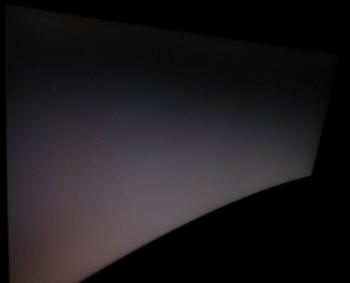
Above: View
of an all black screen from the side. Click for larger version
On a black image there is a characteristic
pale glow introduced to the image when viewed from a wide angle, commonly
referred to as IPS glow. This type of glow is common on most modern IPS-type
panels and can be distracting to some users. If you view dark content from a
normal head-on viewing position, you can actually see this glow as your eyes
look towards the edges of the screen. Because of the sheer horizontal size of
this 37.5" panel, the glow towards the edges is more obvious than on small
screens, where there isn't such a long distance from your central position to
the edges. Some people may find this problematic if they are working with a lot
of dark content or solid colour patterns. In normal day to day uses, office
work, movies and games you couldn't really notice this unless you were viewing
darker content. If you move your viewing position back, which is probably likely
for movies and games, the effect reduces as you do not have such an extreme
angle from your eye position to the screen edges. The glow effect was a little
less than on flat ultra-wide screens as the curved nature created a smaller
angle between your eyes and the edges of the screen.

Panel Uniformity
We wanted to
test here how uniform the brightness was across the screen, as well as identify
any leakage from the backlight in dark lighting conditions. Measurements of the
luminance were taken at 35 points across the panel on a pure white background.
The measurements for luminance were taken using BasICColor's calibration
software package, combined with an X-rite i1 Display Pro colorimeter with a
central point on the screen calibrated to 120 cd/m2. The below
uniformity diagram shows the difference, as a percentage, between the
measurement recorded at each point on the screen, as compared with the central
reference point.
It is worth
noting that panel uniformity can vary from one screen to another, and can depend
on manufacturing lines, screen transport and other local factors. This is only a
guide of the uniformity of the sample screen we have for review.

Uniformity of Luminance
Uniformity Correction = OFF
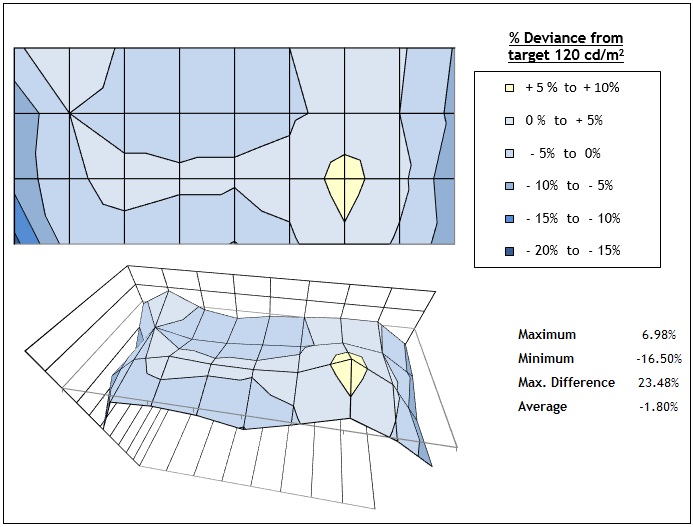
The
VP3881 has a uniformity correction feature which is available in some of the
preset modes, including the factory calibrated sRGB, EBU, SMPTE-C and
Rec.709 colour space modes. This can be turned on and off in each mode and
we will test that in a moment.
Testing the screen first of all with the correction mode turned OFF.
Uniformity of the screen was good on this sample overall. The left and right
hand edges were a little darker than the central area of the screen, where
luminance dipped by -16.5% in the most extreme example (bottom left hand
corner) down to 103 cd/m2. There were only thin areas along these
sides where there was any significant luminance variation. There was also a
bright region in the lower right hand area where luminance peaked at 129
cd/m2 (+6.98%). Overall, 97% of the screen was within a 10%
deviance of the centrally calibrated point which was very good. This was
without the uniformity correction active as well!

Uniformity of Luminance
Uniformity Correction = ON
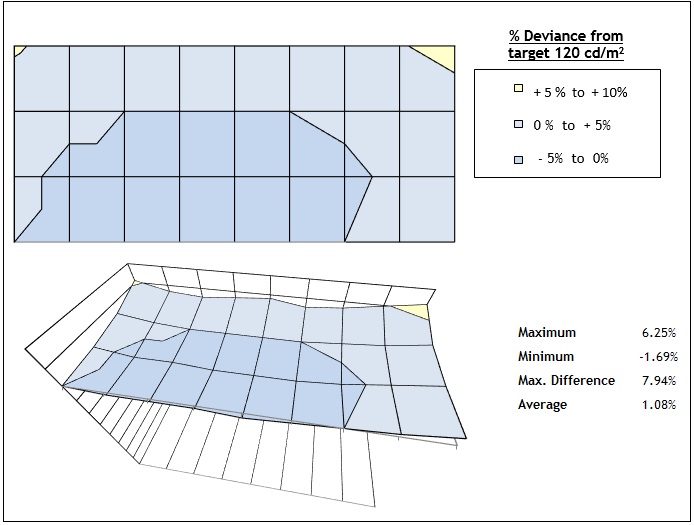
The
screen was switched to the factory calibrated sRGB mode and the uniformity
correction turned on. The uniformity of the screen was improved nicely
bringing the whole screen within a 10% deviance of the centrally
calibrated point. The upper corners seems to stray the most, reaching up to
around 128 cd/m2 at most (+7.94%). You do get an improved uniformity
though across the panel which can be important for colour critical work. It
should be noted that the static contrast ratio is reduced quite
significantly down to around 485:1 when this feature is enabled, due to the
digital white level adjustments being made to the panel to correct the
uniformity. That's typical for any screen with this kind of correction
available.

Backlight Leakage
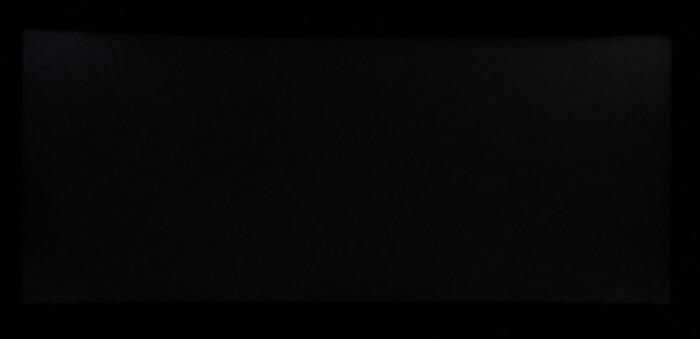
Above: All
black screen in a darkened room. Click for larger version
We also tested the screen with an all black
image and in a darkened room. A camera was used to capture the result. The
camera showed there was no noticeable backlight bleed on this sample, only a
small amount of light clouding in the upper corners captured by the camera.
Note: if you want to test your own screen for
backlight bleed and uniformity problems at any point you need to ensure you have
suitable testing conditions. Set the monitor to a sensible day to day brightness
level, preferably as close to 120
cd/m2 as you can get it (our tests
are once the screen is calibrated to this luminance). Don't just take a photo at
the default brightness which is almost always far too high and not a realistic
usage condition. You need to take the photo from about 1.5 - 2m back to avoid
capturing viewing angle characteristics, especially on IPS-type panels where
off-angle glow can come in to play easily. Photos should be taken in a darkened
room at a shutter speed which captures what you see reliably and doesn't
over-expose the image. A shutter speed of 1/8 second will probably be suitable
for this.

General and Office Applications

One of the key selling points of ultra-wide
screens like the this is it's high resolution and large screen size. The 3840 x
1600 display offers a sharp but comfortable picture. Its pixel area is about 2.2
times larger than an Ultra-Wide Full HD 21:9 monitor (2560 x 1080), and about 3
times larger than a Full HD 16:9 monitor (1920 x 1080). It provides an efficient
environment for using Microsoft Office programs and internet browsing, and split
screen working is a pleasure. You can comfortably have the screen split in to 3
vertical sections if you want which is very nice. Thankfully the high resolution
is of a very comfortable size on the 37.5" panel, with a 0.229mm pixel pitch it
is very comparable to a 27" 2560 x 1440 monitor (0.2331mm) and the popular
ultra-wide 34" 3440 x 1440 displays (0.2325mm). This means you are basically
getting a slightly wider and slightly higher desktop area than the 34" models,
with a similar font size. If you're coming from a lower resolution / larger
pixel pitch you may still find the fonts look quite small to start with, but
like the 27" 1440p models out there you soon get used to it. We continue to
enjoy the curved format of these displays for day to day office work. It just
felt more comfortable than a flat screen on a model as wide as this, bringing
the corners a bit nearer to you. You didn't really notice the curve in normal
use but we liked the feel. Probably down to user taste, so if in doubt try and
see one in person. The extra vertical room compared with a 34" ultrawide was
useful for office uses as well, it's not much but you do notice the extra room.

The thin
bezel design mean that the VP3881 could be integrated into a multi-screen set up
if you wanted, although with the screen as big as it is, you'd need a very big
desk! The light AG coating of the panel is welcome, and much better than
the grainy and 'dirty' appearance of older IPS AG coatings. The
wide viewing
angles provided by this panel technology on both horizontal and vertical planes,
helps minimize on-screen colour shift when viewed from different angles, making
colour work and photo viewing a pleasure.
The default factory setup of the screen was very good as well, offering an
accurate gamma curve, accurate white point, good contrast ratio and low dE.
There's a massive range of settings and options to play with as well if you want
to customise the appearance or calibrate to different settings. The support for
hardware calibration is very useful as well if you're doing any colour critical
work or photo editing as you can store the calibration in the screen itself, and
forget about ICC profiles and getting them working correctly in different
applications.

There are
preset modes available for 'web' and 'text' in the OSD menu, along with loads of
different presets for designer and photographer uses. Too many to really cover
in detail here, but certainly plenty to experiment with and for different unique
uses.
The
brightness range of the screen was also very good, with the ability to offer a
luminance between 328 and 47 cd/m2. This should mean the screen is
perfectly useable in a wide variety of ambient light conditions, including
darkened rooms. A setting of ~24 in the OSD brightness control should return you
a luminance close to 120 cd/m2 out of the box. On another positive
note, the brightness regulation is controlled without the need for the use of
Pulse-Width Modulation (PWM), and so those who suffer from eye fatigue or
headaches associated with flickering backlights need not worry. There was no
audible noise or buzzing from the screen, even when specifically looking for it
using test images with a large amount of text at once. The screen also remains
cool even during prolonged use.
The screen offers 3x USB 3.0 ports which is
very handy, although they are on the back of the screen with the input
connections so not really that easy access. There are 2x 5W integrated stereo speakers on this model,
and there is also an audio input and output connection available.
There aren't any other extras like card readers or ambient light sensors offered
though which can sometimes be useful in office environments. The stand offers a
wide range of adjustments which is great news, allowing you to obtain
comfortable viewing positions.

Responsiveness and Gaming
|
Panel Manufacturer and
Technology |
LG.Display |
|
Panel Part |
LM375QW1-SSA1 |
|
Quoted G2G Response Time |
7ms G2G (with OD), 14ms G2G
typ |
|
Quoted ISO Response Time |
n/a |
|
Overdrive Used |
Yes |
|
Overdrive Control
Available Via OSD Setting |
Response Time |
|
Overdrive OSD Settings |
Standard, Advanced, Ultra
Fast |
|
Maximum
Refresh Rate |
60Hz |
|
Variable
Refresh Rate technology |
n/a |
|
Variable
Refresh Rate Range
|
n/a |
|
Blur
Reduction Backlight |
n/a |
The VP3881 is rated by ViewSonic as having a
14ms G2G typical response time, reduced down to 7ms G2G with Overdrive
apparently. The screen uses
overdrive / response time compensation (RTC) technology to boost pixel
transitions across grey to grey changes as with nearly all modern displays.
There is a user control in the OSD menu for the overdrive under the 'Response
Time' setting with 3 options available - Standard, Advanced and Ultra Fast. The part
being used is
an LG.Display LM375QW1-SSA1 IPS technology panel. Have a read
about response time in our
specs section if you need additional information about this measurement.
We use an
ETC M526
oscilloscope for these measurements along with a custom photosensor device.
Have a read of
our response time measurement article for a full explanation of the testing
methodology and reported data.



We carried out some initial response time
measurements in each of the overdrive settings, along with some visual tests in
order to identify what the optimal setting was. In the standard mode, response
times were pretty slow, with an average of 15.4ms G2G measured and several of
them creeping up above 20ms. The overdrive impulse was basically turned off
here, although that did mean there was no overshoot at all which was good. This
mode produces some fairly obvious blurring on moving content though.
Pushing up to the 'Advanced' mode brought
about some noticeable improvements in our measurements and in visual tested.
Moving objects became a bit sharper and clearer, and motion clarity improved. You can see that the average G2G had dropped now to 10.8ms which was
still fairly slow, and some low levels of overshoot were starting to creep in
here as well. The 'Ultra Fast' mode didn't seem to offer any real improvements
in response times, only knocking the average down to 10.5ms G2G, but high levels
of overshoot were now a problem and dark trails became noticeable in practice.
Stick to the 'Advanced' response time setting on this screen for optimal
performance.

Detailed Response Time Measurements
Response Time mode = Advanced
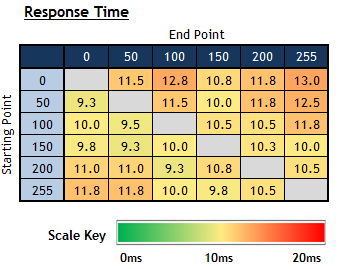
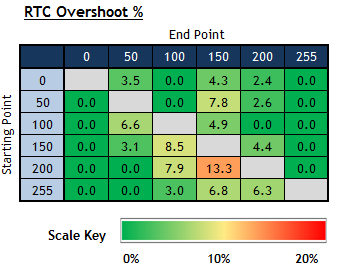
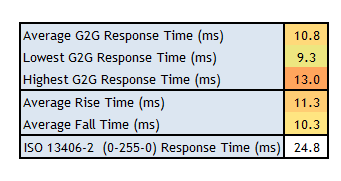
Having settled on the 'Advanced' response time
mode in our earlier measurements and visual tests we carried out a more thorough
set of measurements across a wider range of pixel transitions. The average G2G
figure was measured at 10.8ms now which was fairly slow even for an IPS-type
panel at 60Hz. In the best cases, a 60Hz IPS panel can get down to around 8.5ms
G2G without overshoot becoming a problem, and so the VP3881 was a bit behind
that. There was some low levels of overshoot evident here as well, although not
at any level you should see in practice. This was an indication that you
probably couldn't improve the response times much more without the overshoot
becoming a significant problem.
Remember, this screen is not aimed at gaming
really at all, and is aimed at more colour critical work and professional uses.
It is limited to 60Hz refresh rate as well, so can't offer the high frame rates
and improved motion clarity that high refresh rate panels can deliver. The
response times here are adequate for some light and moderate gaming, and
certainly for movies and multimedia. You probably wouldn't want to do any
competitive or FPS gaming on this screen though, but you probably wouldn't be
looking at a model like this if that was your intended usage anyway.

Gaming Comparisons
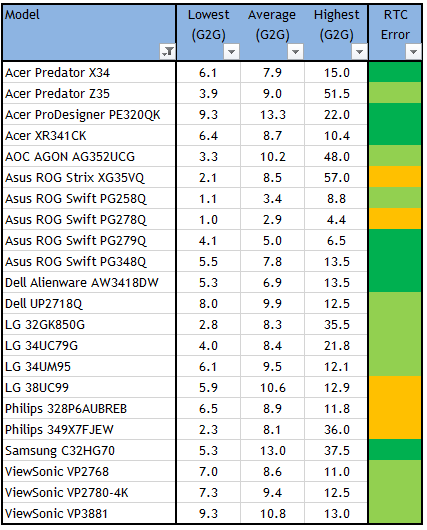
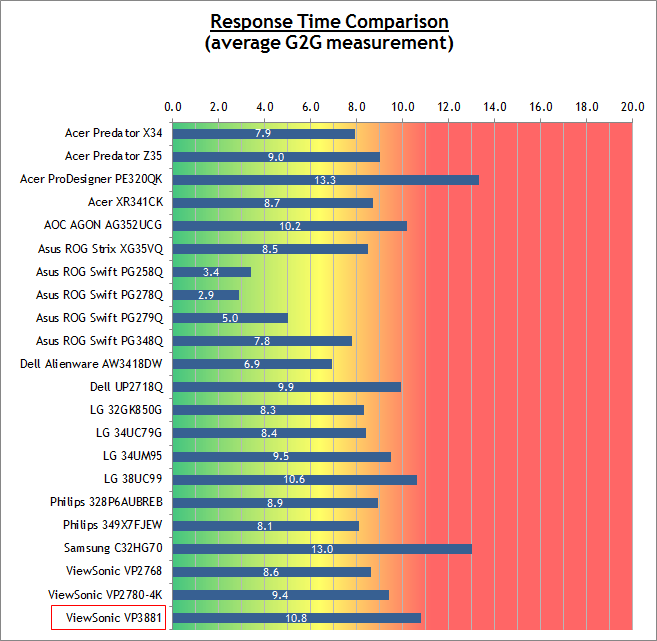
We have provided a comparison of the VP3881 against many other screens that we have tested.
The overall responsiveness was unsurprisingly pretty close to the
LG 38UC99 which features the same
LG.Display IPS panel. On the ViewSonic we measured 10.8ms G2G average response
time with very low levels of overshoot evident at the optimal settings. On the
LG model we measured 10.6ms G2G, and some transitions pushed to even faster
speeds, but at the cost or higher levels of overshoot which were more noticeable
in practice. This 37.5" IPS panel obviously isn't the fastest, although the
ViewSonic is not aimed at gaming at all. There are faster IPS panels around if
you're looking for an ultrawide gaming screen, particularly those with high
refresh rate support as well like the
Dell Alienware AW3418DW and
Acer Predator X34 for instance.
They offer faster response times and also show better motion clarity and lower
blurring thanks to the higher refresh rate. They are completely different
markets though.

Additional
Gaming Features
-
Aspect Ratio Control -
the screen has 3 options for
hardware level
aspect ratio control
options, with settings for 'full screen', 4:3 and 1:1 pixel mapping offered.
The 1:1 mode is useful as there's settings to match the input aspect if it is
different to the native 24:10 of this screen, although we would have liked to
have seen an "aspect" mode as well to fill as much of the screen as possible
while keeping the source aspect ratio. That could have been useful for
external inputs which often operate at 16:9.
-
Preset Modes -
There are a few preset modes in
the 'ViewMode' menu designed for gaming, including FPS1, FPS2, RTS and MODA
modes. This might be useful if you want to set the screen up for different
uses and save different settings for gaming.

Lag
We have written an in depth article about
input lag and the various measurement techniques which are used to evaluate
this aspect of a display. It's important to first of all understand the
different methods available and also what this lag means to you as an end-user.
Input Lag vs. Display Lag vs. Signal
Processing
To avoid confusion with different terminology
we will refer to this section of our reviews as just "lag" from now on, as there
are a few different aspects to consider, and different interpretations of the
term "input lag". We will consider the following points here as much as
possible. The overall "display lag" is the first, that being the delay between
the image being shown on the TFT display and that being shown on a CRT. This is
what many people will know as input lag and originally was the measure made to
explain why the image is a little behind when using a CRT. The older stopwatch
based methods were the common way to measure this in the past, but through
advanced studies have been shown to be quite inaccurate. As a result, more
advanced tools like SMTT provide a method to measure that delay between a TFT
and CRT while removing the inaccuracies of older stopwatch methods.
In reality that lag / delay is caused by a
combination of two things - the signal processing delay caused by the TFT
electronics / scaler, and the response time of the pixels themselves. Most
"input lag" measurements over the years have always been based on the overall
display lag (signal processing + response time) and indeed the SMTT tool is
based on this visual difference between a CRT and TFT and so measures the
overall display lag. In practice the signal processing is the element which
gives the feel of lag to the user, and the response time of course can
impact blurring, and overall image quality in moving scenes. As people become
more aware of lag as a possible issue, we are of course keen to try and
understand the split between the two as much as possible to give a complete
picture.
The signal processing element within that is
quite hard to identify without extremely high end equipment and very complicated
methods. In fact the studies by Thomas Thiemann which really kicked this whole
thing off were based on equipment worth >100,1000 Euro, requiring extremely high
bandwidths and very complicated methods to trigger the correct behaviour and
accurately measure the signal processing on its own. Other techniques which are
being used since are not conducted by Thomas (he is a freelance writer) or based
on this equipment or technique, and may also be subject to other errors or
inaccuracies based on our conversations with him since. It's very hard as a
result to produce a technique which will measure just the signal processing on
its own unfortunately. Many measurement techniques are also not explained and so
it is important to try and get a picture from various sources if possible to
make an informed judgement about a display overall.
For our tests we will continue to use the
SMTT tool to measure the overall "display lag". From there we can use our
oscilloscope system to measure the response time across a wide range of grey to
grey (G2G) transitions as recorded in our
response time
tests. Since SMTT will not include the full response time within its
measurements, after speaking with Thomas further about the situation we will
subtract half of the average G2G response time from the total display lag. This
should allow us to give a good estimation of how much of the overall lag is
attributable to the signal processing element on its own.
Lag Classification
To help in this section we will also introduce a broader classification system
for these results to help categorise each screen as one of the following levels:
-
Class 1)
Less than 16ms / 1 frame lag at 60Hz - should be fine for gamers, even at high
levels
-
Class 2)
A lag of 16 - 32ms
/ One to two frames at 60Hz - moderate lag but should be fine for many gamers.
Caution advised for serious gaming
-
Class 3)
A lag of more than
32ms / more than 2 frames at 60Hz - Some noticeable lag in daily usage, not
suitable for high end gaming
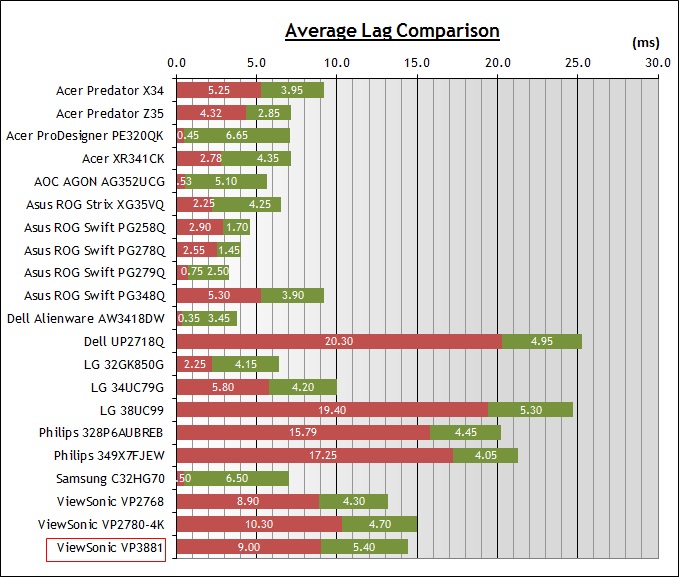
For the full reviews of the
models compared here and the dates they were written (and when screens were
approximately released to the market), please see our
full
reviews index.
|
|
Low
Input Lag Mode |
|
(Measurements in ms) |
Off |
Advanced |
Ultra Fast |
|
Total Display Lag
(SMTT 2) |
17.00 |
14.40 |
15.57 |
|
Pixel Response Time
Element |
5.40 |
5.40 |
5.40 |
|
Estimated Signal
Processing Lag |
11.60 |
9.00 |
10.17 |
|
Lag Classification |
1 |
1 |
1 |
|

Class 1 |
We have provided a comparison above against
other models we have tested to give an indication between screens. The screens
tested are split into two measurements which are based on our overall display
lag tests (using SMTT) and half the average G2G response time, as measured by
the oscilloscope. The response time is split from the overall display lag and
shown on the graph as the green bar. From there, the signal processing (red bar)
can be provided as a good estimation.
We measured the lag in each of the 3 'Low
Input Lag' modes. The 'Advanced' mode seemed to be optimal, and offered a
slightly lower lag than the 'Off' mode, and actually slightly lower than the
higher 'Ultra Fast' setting oddly. A total display lag of 14.40ms was
measured in 'Advanced' mode.
With approximately 5.40ms of that accounted for by pixel response times we had
an estimated signal processing of just 9.0ms, which was pretty good for a 60Hz
screen and just over half a frame of delay. This was a good result from a screen
which is not really aimed at gaming at all and in keeping with the other
ViewSonic screens we've included in the comparison here (27" sized models again
not aimed at gaming really).

Movies and Video
The following summarises the screens
performance for videos and movie viewing:
|
Category |
Display
Specs / Measurements |
Comments |
|
Size |
37.5" widescreen |
Large for
desktop display |
|
Aspect Ratio |
24:10 |
Can support wider screen
content than common 16:9 which is useful for movies |
|
Resolution |
3840 x 1600 |
Can support native 1080p
content, but not quite Ultra HD natively which requires a higher vertical
resolution of 2160. |
|
HDCP |
Yes v2.2 |
Suitable for encrypted
content across all ports |
|
Connectivity |
DisplayPort 1.2, USB
Type-C and 2x HDMI 2.0 |
Useful additional HDMI
input for external Blu-ray players or games consoles. Capable of
supporting the high resolution as well |
|
Cables |
USB type-C, DisplayPort and HDMI |
All three provided in the box
which is good news |
|
Ergonomics |
Tilt, height, swivel |
Good range of
adjustments with most being easy to use. You should be able to position the screen for multiple viewing
positions. |
|
Coating |
Light Anti-glare |
Provides clear,
non-grainy image and avoids unwanted reflections of full glossy solutions |
|
Brightness range |
47 - 328 cd/m2 |
Good adjustment range
offered. Flicker free backlight operation with no PWM |
|
Contrast |
1058:1 after calibration |
Strong contrast ratio for
an IPS panel, helping provide good clarity in shadow detail
and darker content. Cannot compete with VA technology though in this area. |
|
Preset modes |
Movie |
There is a specific movie preset
mode in the menu, so you can set this up to your liking for movie viewing
if you want |
|
Response times |
10.8ms G2G, low
overshoot |
Decent enough overall and
adequate for movie viewing certainly. Stick with the 'Advanced' response
time setting. |
|
Viewing angles |
Very good |
Thanks to the IPS panel
technology, suitable for viewing from a wide range of positions. IPS glow
on dark content could present a problem from some wider angles especially
in darker room conditions. |
|
Backlight bleed |
Very good |
No backlight bleed on our
sample (may vary) which is good, as that can be particularly problematic
on movies with black borders. |
|
Audio |
Audio in/out and 2x 5W
speakers |
Basic integrated speakers
could handle the odd YouTube video or mp3. Audio input and output provided
also for external connectivity. |
|
Aspect Ratio Controls |
Full, 4:3 and
1:1 |
Good options to account
for non-native format inputs if needed which is probably useful for the
wide range of 16:9 aspect ratio devices out there. |
|
PiP / PbP |
Both supported |
May be useful given the
very large screen size here |
|
HDR support |
No |
HDR10 support is talked
about in the product specifications and on ViewSonic's website but as far
as we can tell this is nothing more than "support" for HDR10 input over
the video interfaces. The screen does not offer any HDR display capability
as it has no local dimming from the backlight, no increased peak
brightness and therefore no improvements in the dynamic range. It is also
an sRGB gamut screen so there is also no boost in the colour space here.
It's not an HDR screen. |

Conclusion
A great deal of time and effort goes in
to the content at TFTCentral, and we are very grateful for the support our
readers show through donations and thank yous. If you would like to support the
site and help us continue to produce high quality, detailed content, we would
welcome a
donation
no matter how small or large. Thank you.
The VP3881 offered a very good performance if
you are looking for a large format screen for more general or professional uses.
The large screen size and resolution is a pleasure to work with for split screen
multi-tasking and gives you a huge area in which to work. The extra resolution
compared with common 34 - 35" ultrawide models was noticeable, in a similar way
as some people prefer 16:10 1920 x 1200 format models to 16:9 1920 x 1080. The
screen offers a very good range of options and features for colour critical work
as well. We were pleased with the default out of the box setup, as well as the
wide range of factory calibrated colour modes. There's a huge range of options
in the OSD to tweak, and support for hardware calibration brings that extra
high-end control and accuracy to the screen which was great to see. The display
can support 10-bit colour depth if you've got the relevant workflow and hardware
to support it, but the only 'missing' thing here for a colour critical display
is support for wider colour spaces beyond sRGB. That will only be an issue if
you actually want to work with wide gamut content of course, but just one to
keep in mind. The additional uniformity correction mode works very well and is a
feature normally reserved for professional grade screens, so it was good to see
it included here.
The IPS technology panel offers solid all
round performance with a stable image and consistent viewing angles. The
contrast ratio was good at around 1058:1 after calibration although this
technology can't compete with VA panels in this area. IPS is still the preferred
choice for colour critical work thanks to the viewing angles though. You may
notice the IPS glow on dark content when viewed from an angle in darker room
conditions a little more because of the large horizontal size of the display,
but the level of glow is fairly typical for this technology. Response times were
only moderate but certainly capable of some light gaming, and fine for
multimedia and movies. This isn't a gaming screen at all, so that's not a major
issue although on the flip side it did offer a low lag which was perhaps
surprising. Our only real gripes with the VP3881 were the fiddly OSD control
buttons which were not that intuitive to use. A small joystick would make life
easier we felt. The screen can handle HDR10 content, but does not offer any
technologies like local dimming to actually display HDR properly or provide a
boosted dynamic range so that's an area missing on this screen. We are only
really picking up on this because the marketing specifically talks about HDR and
we wanted to help avoid any confusion.
All in all it's a great all round display and
if you're looking for a large format display for more general or colour critical
work (as opposed to lots of gaming) then it's a great option.
|
Pros |
Cons |
|
Large screen size and
resolution well suited to office and colour work |
Response times are
moderate, although this is not a gaming screen |
|
Good factory setup, loads
of settings and preset modes and hardware calibration support |
No 'real' HDR support
from the display |
|
Added professional grade
features like uniformity correction |
OSD controls are a bit
fiddly |
|
Check Pricing and Buy - Direct Links
|
|
Amazon
|
|
TFTCentral is a participant
in the Amazon Services LLC Associates Programme, an affiliate
advertising programme designed to provide a means for sites to earn
advertising fees by advertising and linking to Amazon.com, Amazon.co.uk,
Amazon.de, Amazon.ca and other Amazon stores worldwide. We also
participate in a similar scheme for Overclockers.co.uk. |
|
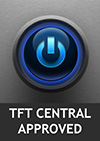
|
TFT Central Awards Explained
We have two award
classifications as part of our reviews. There's the top 'Recommended'
award, where a monitor is excellent and highly recommended by us. There is
also an 'Approved' award for a very good screen which may not be perfect,
but is still a very good display. These awards won't be given out every
time, but look out for the logo at the bottom of the conclusion. A list of
monitors which have won our awards is available
here. |